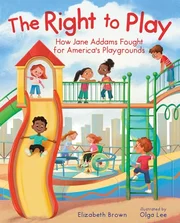At 5 years old, Jane watches her friends run and play while she sits at the window, her spine crooked from tuberculosis. Eventually, she learns that playing outside actually makes her body stronger. The power of play informs much of Jane’s adult life. Spurred by a visit to a settlement hall in London that provides housing and services for immigrants, she opens a similar facility in Chicago, Hull House. She helps develop safe programming for kids and coordinates the construction of one of the first model playgrounds in America, inspired by outdoor gymnasiums she’d seen in Europe. She goes on to design accessible playground equipment for kids with disabilities, is elected to the Playground Association of America, and even helps pass federal child labor laws. Jane is awarded the Nobel Peace Prize in 1931. The cheerful, colorful cartoon illustrations will attract younger readers but do little to portray the story’s somber moments, with barely any distinction among characters’ facial features and expressions. Readers will be interested to know about the activism behind the first public playgrounds, though this account is bogged down by clunky writing and too many details.
Categories
THE RIGHT TO PLAY
